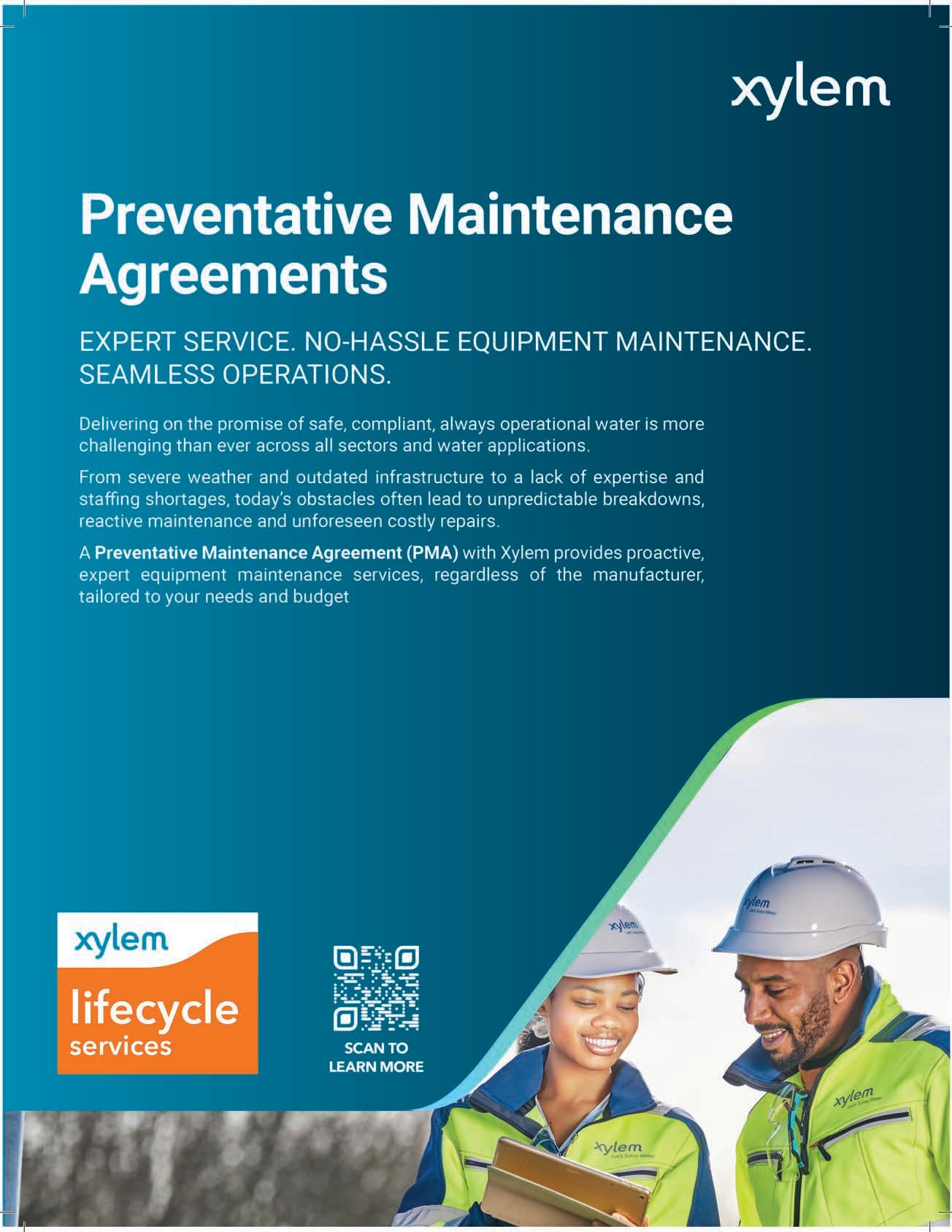












































































































Issue 47, inside this issue
As the 1998 White Paper on Local Government undergoes a review, we explore how all spheres of society can help reshape local governance.
8 IN BRIEF
A dynamic Africa: urbanisation and growth across the continent.
9 OP-ED: LAND MATTERS
We explore how the enactment of South Africa’s Expropriation Act has intensi ed tensions between Pretoria and Washington
18 REVIEW OF LOCAL GOVERNMENT
We unpack if local government reforms, as outlined by Cyril Ramaphosa in his 2025 SONA, will bring about the anticipated changes South Africans so sorely need.
How does the lack of service delivery at municipalities countrywide impact human rights?
32
Why civic education is the key to unlocking youth potential.
34
Can investing in new projects and engaging citizens in conservation help solve the water crisis?
39 SERVICE DELIVERY
We highlight the innovations and transformation development taking place in Gauteng.
42
Key takeaways from SALGA’s National Communicators Forum and the Building Resilient Municipalities conference.
Local government is often the rst point of contact between citizens and the state. It is here, at the municipal level, where policies transform into action and the realities of governance are most keenly felt. Yet, for too long, inef ciency, poor leadership and nancial mismanagement have hindered the ability of municipalities to deliver on their mandate. As President Cyril Ramaphosa outlined in his 2025 State of the Nation Address, reforming local government is critical to the broader renewal of South Africa’s democratic institutions. But will these reforms be enough?
In this edition of Voice of Local Government, we take a deep dive into the challenges and opportunities facing municipalities today. Our expert contributors explore whether the proposed changes in governance structures, funding models and leadership development strategies can nally turn the tide and restore public con dence in local government.
Can a new approach bring about the ef ciency and service delivery communities desperately need?
We also examine how these governance challenges intersect with human rights, particularly in light of the dire consequences service delivery failures have on citizens’ basic rights. From access to clean water and sanitation to adequate housing and healthcare, the effectiveness of municipalities plays a direct role in the wellbeing of South Africans.
So, as we navigate the complexities of local government reform, one thing remains clear: transformation is not optional, it is imperative. The time for half-measures has passed. Now is the moment to ensure municipalities serve as engines of growth, inclusion and service delivery, rather than sites of stagnation and dysfunction.
We invite you to engage with the ideas, debates and solutions presented in this issue and to be part of the conversation that will shape the local governments of tomorrow.
Raina Julies

Director, Marketing & Communication: Tebogo Mosala
Communication & Marketing Officer: Marelda Boshielo
Marketing Officer: Valerie Setshedi
PICASSO EDITORIAL & PRODUCTION TEAM
Content Manager: Raina Julies, rainaj@picasso.co.za
Contributors: Marchelle Abrahams, Ryland Fisher, Matthew Hirsch, Puleng Khunou, Itumeleng Mogaki, Busani Moyo, S’thembiso Msomi, Wellington Radu, Monei Seleho
Copy Editor: Brenda Bryden
Content Co-ordinator: Natasha Maneveldt
Head of Design: Jayne Macé-Ferguson
Senior Designer: Mfundo Archie Ndzo
Cover Images: Supplied
Sales Project Manager: Jerome van der Merwe, jeromem@picasso.co.za
Sales Team: Jacqueline Bezuidenhout, Natasha Hendricks
Production Editor: Shamiela Brenner
Advertising Co-ordinator: Shamiela Brenner
Subscriptions and Distribution: Fatima Dramat, fatimad@picasso.co.za
Business Manager: Lodewyk van der Walt Lodewykv@picasso.co.za
Management Accountant: Deidre Musha
General Manager, Magazines: Jocelyne Bayer
Published by Picasso Headline, a proud division of Arena Holdings

Hill on Empire, 16 Empire Road (cnr Hillside Road), Parktown, Johannesburg, 2193
Postal Address: PO Box 12500, Mill Street, Cape Town, 8010 www.businessmediamags.co.za
Printing: CTP Printers, Cape Town
Follow and like us to keep up to date with SALGA news.




Copyright: Picasso Headline and SALGA. No portion of this magazine may be reproduced in any form without written consent of the publisher. The publisher is not responsible for unsolicited material. Voice of Local Government is published quarterly by Picasso Headline. The opinions expressed are not necessarily those of SALGA or Picasso Headline. All advertisements/advertorials and promotions have been paid for and therefore do not carry any endorsement by SALGA or the publisher.
Policy reviews are not a disruption – they’re an opportunity to reflect, refine and respond to a changing world. As the 1998 White Paper on Local Government undergoes its long-awaited review, this edition of Voice of Local Government explores how this pivotal moment invites all spheres of society to help reshape local governance. From improving municipal sustainability to enhancing community participation, we delve into the policy shifts and the communication strategies that will define the next era of responsive, effective and inclusive local government, writes the SALGA Editorial team
Public policy reviews shouldn’t evoke the anxiety sometimes connected with such endeavours. Policies, much like the constitution of any country, aren’t static. They are living documents and should be contingent upon the circumstances of the time; simply because time, situations and conditions aren’t static, they change.
Reviews of public policies can be used to nd and address weaknesses and ensure they continue to be relevant for as long as they are implemented. Since society, the people who will bene t from such policies, stands to gain, policy reviews are intrinsically good.
In this regard, President Cyril Ramaphosa, in his February State of the Nation Address, announced the review of the 1998 White Paper on Local Government .
“We will, therefore, undertake extensive consultation to develop an updated White Paper on Local Government to outline a modern and t-for-purpose local government system.
We will review the funding model for municipalities as many of them do not have a viable and sustainable revenue base,” the president said.
For local government, which has long advocated for such a review, the announcement is a much-needed development.
Furthermore, the Discussion Document on the Review of the 1998 White Paper on Local Government (WPLG98) has been formally gazetted by the Department of Cooperative Governance and Traditional Affairs. Public comments can be made until 30 June 2025.
Key aims of the review include:
• Assess and revise outdated assumptions of WPLG98.
• Strengthen co-operative governance among the three spheres of government.
• Align reforms with parallel initiatives such as amendments to the MFMA, Municipal Structures Act and SPLUMA.
• Enhance integration with traditional leadership and improve community participation.
Reviews of public policies can be used to find and address weaknesses and ensure they continue to be relevant for as long as they are implemented.
• Tackle systemic issues such as municipal nancial sustainability, over-politicisation, climate risk and spatial inequality.
The public, civil society, public institutions, interested parties and national, provincial and local government have a great opportunity to shape the future of local government, offer fresh ideas that will open up new avenues for the sector’s growth and development, and help municipalities enhance the services they provide to the citizens and communities they serve.
This edition of Voice of Local Government will discuss these and more issues. Moreover, the role of public sector communicators in helping municipalities better engage their communities, involving them in local decision-making processes and improving public trust in this sphere of government, is another important topic of discussion in this issue. In this regard, communicators from municipalities, government departments and public entities gathered at the Mentors Country Estate in Jeffreys Bay, Eastern Cape, for the eighth National Communicators Forum 2025 for networking, professional development and the exchange of best practices and case studies capturing the state of public sector communication.
For public sector communicators, improving citizen-local government communication in a way that would help people and communities understand the vision, mission and policy objectives of their respective municipalities is still a top priority. This meeting helped guide them through these issues.
This edition promises to be an engaging read, and we hope you pour over the issues that are explored in detail.

Respiratory infections can pose serious health risks, especially for vulnerable groups such as young children, the elderly and those with chronic conditions. Which is why Bonitas Medical Fund has created the Respiratory Illness Hub: A go-to resource for everyone. By
LEE CALLAKOPPEN, Principal Officer of Bonitas

Last year we noted a signi cant increase in hospital admissions for respiratory conditions, including u, pneumonia, H1N1, RSV, HMPV and COVID-19. Due to the health risks, we decided to create an educational hub about respiratory illnesses on our website. This resource is available to all South Africans and contains comprehensive information on everything related to respiratory health.
The aim is to prevent the spread of respiratory illnesses and promote a faster recovery when someone falls ill. Knowledge is power and early detection and prevention has always been a Bonitas strategic focus.
Both RSV and HMPV are being detected at increasing rates, potentially indicating a broader respiratory illness surge. More common in young children and older adults, symptoms are similar to the common cold: Coughing, wheezing, runny nose, sore
throat, fever, fatigue, muscle pain, loss of taste or smell and breathing dif culties.
To avoid getting respiratory illnesses:
• Clean your hands regularly and thoroughly with soap and water or an alcohol-based hand rub
• Avoid touching your eyes, nose or mouth before washing your hands rst
• Wear a mask in crowded or poorly ventilated spaces
• Improve ventilation where possible (open a window for air ow)
• A strong immune system can help fend off infections. Eat a balanced diet, exercise regularly and get enough sleep
• Stay at home if you feel ill
• Cover your nose and mouth with a tissue or bent elbow when coughing or sneezing
Children under 5, adults over 65 and people with weakened immune systems are the most at risk. While anyone can catch HMPV and RSV, infants, older adults
The aim is to prevent the spread of respiratory illnesses and promote a faster recovery when someone falls ill.
and those with health conditions, such as immunosuppression, chronic obstructive pulmonary disease and asthma, are at higher risk for severe illness.
These viruses are spread through infectious respiratory particles circulating through the air.
You can contract the virus if you are in contact with a sick person or share a closed space with them. You can also become infected by touching contaminated surfaces like doorknobs or handles and then touching your eyes, nose or mouth.
Flu can lead to various complications, such as pneumonia, bronchitis, sinus, ear infections and can also worsen chronic medical conditions. Complications are more common in high-risk groups: Healthcare workers, people over 65, those with chronic diseases or comorbidities, pregnant women, if your BMI is over 40 and if you are immunocompromised. Flu viruses mutate quickly but you can protect yourself by having an annual u vaccination to reduce your risk of getting the u and, if you do, your symptoms will be much milder.
Bonitas encourages all South Africans to access the Hub to learn more about these respiratory viruses, how to avoid contracting them and why the u vaccination is recommended.
Take control of your respiratory wellbeing through the Respiratory Illness Hub: www.bonitas.co.za/Respiratory-Hub


8 Roundup of international news.
9 Op-ed: Land matters: the Expropriation Act.
In January 2025, AfriForum representatives visited the United States to express their opposition to South Africa’s Expropriation Act, which allows land expropriation under specific circumstances without compensation. This move has heightened debates within South Africa regarding property rights and land reform. However, if implemented correctly and proactively, the act has the potential to transform neglected areas, enhance urban safety and provide municipalities with the legal tools needed to revitalise South Africa’s cities and towns.

Africa Day, observed annually on 25 May, commemorates the founding of the Organisation of African Unity in 1963, now known as the African Union. This day symbolises the collective aspirations of African nations for unity, liberation and socioeconomic progress.
Source: en.wikipedia.org
The 2025 Africa Day theme centres on National Reconciliation, Restoration of Peace, Security, reflecting the continent’s dedication to addressing internal conflicts and fostering unity.
Source: amaniafrica-et.org
Africa Day serves as a reminder of the continent’s journey toward self-determination and its ongoing efforts to achieve socioeconomic progress, reflecting on past achievements and envisioning a future of unity and prosperity.
Source: daysoftheyear.com
Africa’s Urbanisation Dynamics 2025: Planning for Urban Expansion report provides the most comprehensive view of projected urbanisation dynamics to date with detailed insights into urban population growth and spatial expansion in over 11 000 urban agglomerations across Africa’s 54 countries. Over the next three decades, Africa’s urban population will double, increasing from 700 million to 1.4 billion by 2050, making it the continent with the second-largest urban population after Asia.
The report examines the implications of this growth for urban planning,
governance and nancing. It provides projections, insights and actionable recommendations tailored for policymakers, local governments, development partners and experts.
Africa’s urban transition represents both a pressing challenge and a transformative opportunity. With proactive planning, effective governance and innovative nancing, cities can become engines of inclusive economic growth. It is essential to act now to manage urban growth in ways that foster sustainability, inclusion and resilience, paving the way for a thriving urban future.


Africa’s Urbanisation Dynamics 2025: Planning for Urban Expansion

The enactment of South Africa’s Expropriation Act has intensified tensions between Pretoria and Washington, with United States President Donald Trump leading a vocal campaign against the legislation. Alongside billionaire Elon Musk and Secretary of State Marco Rubio, Trump has accused South Africa of implementing racially discriminatory policies that threaten property rights. Beyond the controversy, can the act be a tool for urban renewal and economic justice, asks S’THEMBISO MSOMI, former editor of the Sunday Times
The enactment of the Expropriation Act has become the latest political action placing South Africa (SA) in the ring line of United States (US) President Donald Trump’s new administration. While political analysts expected Trump’s return to the White House to bring about a radical shift in global geopolitics and trade relations, few foresaw the level of hostility his administration would display toward South Africa.
Trump, along with close allies like South African-born billionaire Elon Musk and US secretary of state Marco Rubio, has repeatedly portrayed South Africa as a country unfairly discriminating against a section of its citizens. At the heart of this stance is Trump’s apparent acceptance of claims made by Afriforum and other lobby groups.
These groups argue that SA is implementing legislation that enables land grabs, undermines private property rights and restricts the right of white Afrikaners to receive education in their language of choice.
While the debate continues regarding the Expropriation Act, the Bela Act and broad-based empowerment policies, legal experts largely agree that these laws align with South Africa’s Constitution and do not pose a direct threat to any individual or racial group.
A legal analysis of the Expropriation Act conducted by Werkmans Attorneys for Standard Bank states that the act does not threaten property rights. As a result,
the bank has con rmed that “it does not warrant any modi cation to our lending policy or risk appetite”.
Rather than focusing on the controversy fuelled by Afriforum’s lobbying efforts, South Africans must consider how the Expropriation Act can be used to improve citizens’ lives and create safer urban spaces.
President Cyril Ramaphosa has advocated using the act to tackle the problem of hijacked buildings in Johannesburg and other cities. Many of these buildings pose serious health and security risks to occupants and surrounding communities.
One key provision of the Expropriation Act allows for expropriation with nil compensation in cases where properties have been abandoned by owners and owe substantial debts in municipal rates and taxes.
Across various cities, numerous dilapidated and abandoned buildings exist due to businesses relocating – often to suburban corporate hubs such as Sandton in Johannesburg or Umhlanga in eThekwini. Unfortunately, many of these abandoned buildings fall into the hands of building hijacking syndicates that illegally collect rent from occupants while neglecting maintenance and safety.

However, expropriating such buildings is only the rst step. Authorities must also navigate the complex challenge of evicting illegal occupants. South African law states that anyone occupying a property for more than a day cannot be evicted without being provided with alternative accommodation. This raises concerns about whether local and provincial governments can afford the cost of relocation.
Deputy Minister of Public Works Sihle Zikalala has dismissed these concerns, explaining the law does not require the state to provide illegal occupants with fully built homes or apartments. Instead, they can be allocated land on which to construct temporary structures. Additionally, in cases where occupants are undocumented immigrants, the state can facilitate their repatriation.
Until any aspects of the Expropriation Act deemed unconstitutional are successfully challenged in court, the legislation remains a reality. Local governments must carefully study how it can be leveraged to reclaim and rehabilitate urban spaces while balancing legal and human rights considerations.
With proactive implementation, the act has the potential to transform neglected areas, enhance urban safety and provide municipalities with the legal tools needed to revitalise SA’s cities and towns.
Legal experts largely agree that these laws align with South Africa’s Constitution and do not pose a direct threat to any individual or racial group.


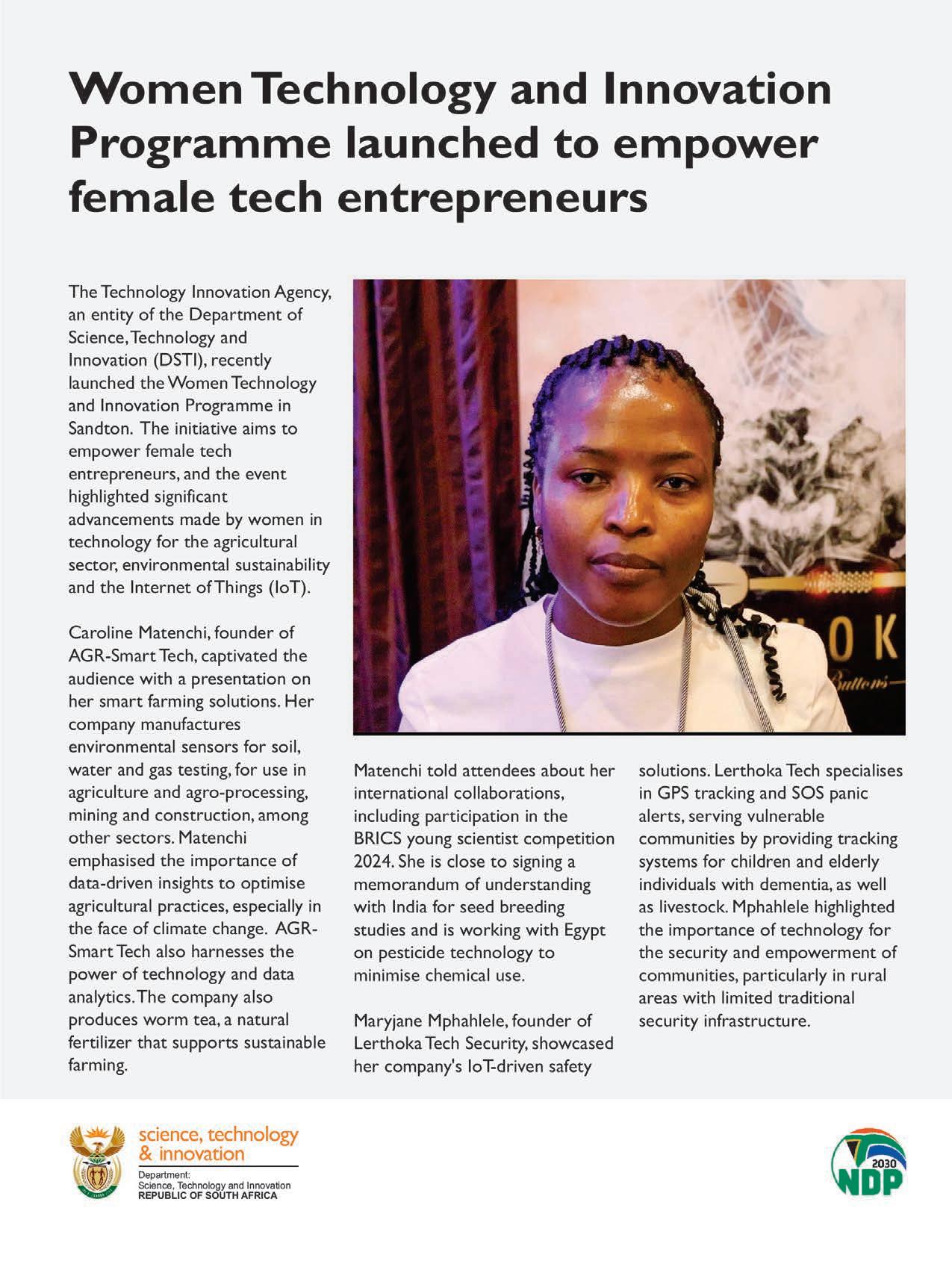



18 Turning the tide: can local government reforms fix South Africa’s service delivery crisis?
We analyse the key reforms proposed in President Cyril Ramaphosa’s 2025 SONA speech, examining its feasibility, timelines and impact on service delivery.
22 Rewriting the blueprint: will the White Paper on Local Government review bring real change?
The White Paper on Local Government, first introduced in 1998, set the foundation for South Africa’s municipal governance system. However, decades later, many municipalities face financial instability, service delivery failures and governance challenges. Is this evidence that the white paper may be fundamentally flawed?
24 A review of the local government funding model: can a new local government funding model save municipalities?
South Africa’s municipalities face a financial crisis, with many struggling to provide basic services due to debt, inefficiency and declining revenue collection. President Ramaphosa’s 2025 SONA speech highlighted a planned review of the local government funding model, but will it be enough to turn things around?
26 Beyond policy: the leadership challenge in South Africa’s local government rescue strategy. While policy reforms are crucial, their success depends on leadership at municipal level. We explore the human factor – mayors, councillors and municipal managers who must implement change.
28 Is there an opportunity to unlock municipal growth by stimulating infrastructure investments?
The critical role of infrastructure quality, from roads and ports to telecommunications and utilities, in fostering investment and improving the quality of life cannot be overstated. This becomes even more imperative at municipal level where the objective is to elevate basic service delivery.
30 Dignity through delivery: can local government uphold human rights by fixing basic services?
Access to clean water, electricity, sanitation and housing is not just about service delivery; it’s a fundamental human right. Yet, millions of South Africans still struggle with failing infrastructure, water shortages and unreliable municipal services. As local government reforms take centre stage, can improved service delivery restore human dignity, equality and social justice?
32 Education is the key to unlocking youth potential. While South Africa has made remarkable progress in strengthening its democracy, a critical challenge persists: mobilising youth civic participation.
34 Can South Africa’s Infrastructure Fund fix the water crisis?
Despite being a water-scarce country, South Africa loses billions of rands worth of water annually due to illegal connections and failing infrastructure. The government’s Infrastructure Fund has secured R36-billion in blended finance packages to support major water projects, including the Polihali Dam under the Lesotho Highlands Water Project. But will this be enough to stop wastage and ensure a sustainable water supply?
The MUNICIPAL DEMARCATION BOARD is rolling out the ward delimitation process in preparation for the 2026 local government elections


The Municipal Demarcation Board (MDB) delimits wards every ve years preceding the local government elections in compliance with the Municipal Structures Act 117 of 1998, schedule 1 as amended (MSA). The plan is to hand over the nal wards to the Electoral Commission of South Africa (IEC) towards the end of the year.

The education and awareness drive on the ward delimitation process commenced in July 2024 to allow members of the public and stakeholders suf cient time to understand the process and participate effectively and make informed inputs. The education and awareness programme was followed by the technical consultations which
The MDB has commenced with the nationwide public consultations from April to June 2025. During these consultations, the MDB will be able to obtain views from members of the public, before the board delimits and finalises the wards.
commenced in November 2024 and were completed in March 2025. The intention of the technical consultations is for the MDB to meet with municipal councillors and of cials responsible for planning to assist the MDB with the preparation of the draft wards.
Subsequently, the MDB has commenced with the nationwide public consultations from April to June 2025. During these consultations, the MDB will be able to obtain views from members of the public, before the board delimits and nalises the wards.
The guide regarding the process of ward delimitation and the requisite information at every stage of the process is found at this link: https://arcg.is/1jC9nn1, which can also be accessed by using the QR code below.
Additionally, written submissions will be accepted from 3 April 2025 until 30 June 2025 at 23:59 (no late submissions will be accepted). Members of the public are encouraged to seize this opportunity by attending the consultation sessions in large numbers and expressing their views on how their wards should be con gured. The schedule for the public consultations is available on www.demarcation.org.za






IEC provides the municipal segment of the national common Voters’ Roll Electoral Act 73 of 1998.
Minister of CoGTA determines the formulae for determining the number of councillors of Metros, Districts and Local Municipalities in terms of section 20(1) and (2) of the MSA.
MEC determines the number of councillors for all municipalities in their respective provinces in terms of section 20(3), (4) and (5) of the MSA.
Municipal Demarcation Board determines the number of wards for municipalities and delimit wards for local government elections in terms of schedule 1 of the MSA.
Municipal Demarcation Board publishes wards in provincial gazettes and invites any person aggrieved by a delimitation to submit objections within 14 days of publication.
Municipal Demarcation Board considers written objections received and either, confirm or vary its delimitation. The final decision is published in provincial Gazettes.
The MDB submits the final ward boundaries to the IEC to prepare for local government elections.
Public trust in local government has reached a historic low, driven by corruption, mismanagement and service delivery failures. President Cyril Ramaphosa’s proposed reforms, outlined in his 2025 State of the Nation Address, have sparked debate among civil society and political commentators. Will his renewal plan be enough to turn the tide, or is local government too deeply entrenched in dysfunction, asks MATTHEW HIRSCH

Municipalities across South Africa are facing mounting criticism due to poor service delivery, financial instability and governance failures. Corruption and mismanagement have further eroded public trust, prompting President Cyril Ramaphosa to announce a renewed effort to clean up local governance.
In his State of the Nation Address (SONA) in February, President Ramaphosa highlighted municipal renewal as a key priority. Under Operation Vulindlela, his government aims to improve service delivery, invest in mass infrastructure and address governance shortcomings. Ramaphosa acknowledged that many of the challenges in municipalities stem
from structural issues. To address this, he pledged a comprehensive review of the White Paper on Local Government to create a more effective municipal system. Additionally, he announced plans to introduce a graduate recruitment programme to attract skilled professionals to the public service.
In many cities and towns across the country, he said, roads are not being maintained, water and electricity supply is often intermittent, garbage is not being collected and sewage is leaking into the streets. Many municipalities lack the technical skills and resources to meet the needs of their residents.
To tackle nancial instability, the government will also reassess the funding model for municipalities, as many currently operate without a sustainable revenue base.
SYSTEMIC FAILURES AND LACK OF OVERSIGHT
Julius Kleynhans, executive manager of the Local Government Division at the Organisation Undoing Tax Abuse (OUTA), argues that municipal failures are systemic. He points to the oversight role of councillors, many of whom lack the necessary quali cations and experience to manage local government effectively.
“If you look at councillors, they are not necessarily quali ed or experienced, yet they oversee council performance and nances. They vote on budgets, but their lack of expertise undermines accountability,” he explains.
Kleynhans also criticises the weak performance indicators for municipal of cials. “Even when local government of cers meet their performance targets, municipalities often end up in a worse state than before,” he says.
This disconnect between of cial performance evaluations and the lived reality of residents highlights the failure of accountability mechanisms. “We need performance metrics that truly measure service delivery outcomes, not just administrative processes,” says Kleynhans.

CORRUPTION OR CAPACITY DEFICIT?
Another key issue plaguing local government is the excessive outsourcing of essential services to consultants and external service providers. Kleynhans argues that this is often due to a lack of internal capacity within municipalities. “Over time, municipalities have become increasingly dependent on external
“We need performance metrics that truly measure service delivery outcomes, not just administrative processes.” – Julius Kleynhans
parties, whether due to corruption or simply because their administration lacks the competence to handle core functions,” he says.
This over-reliance on consultants not only drains municipal budgets, but also reduces accountability. “When services are outsourced, it becomes even harder to hold anyone responsible for failures,” Kleynhans explains.
While local government is at the centre of the crisis, Kleynhans argues that national and provincial authorities have also failed in their oversight roles.
“It’s easy to blame municipalities, but national and provincial governments have not done their jobs either. The lack of intervention over the years has allowed local governance to deteriorate to this point.” He adds that “rather than addressing the root causes, the government introduces short-term interventions that merely treat the symptoms”.
Kleynhans also points to the high level of political interference in municipal governance. “Local government has become highly politicised, and there is little to no consequence management,” he states.
One of the major problems, he explains, is the in uence of unions in protecting underperforming municipal employees. “Unions step in and shield individuals from accountability, further weakening oversight,” he says.
There is also a lack of separation of powers between political and administrative roles, leading to con icts of interest and inef cient governance.
One of the common arguments used to justify municipal underperformance is a lack of funding. Kleynhans disagrees, saying: “The problem isn’t insuf cient funds – it’s the inef cient use of resources. There’s no real accountability for nancial mismanagement, and the lack of proper planning and implementation has a devastating impact on service delivery.”
Kleynhans believes nancial oversight must be strengthened to ensure public funds are used ef ciently.
To address municipal failures, Kleynhans suggests stronger enforcement of Section 139 of the South African Constitution, which allows the provincial government to intervene when a municipality fails to meet its obligations.
“When a municipality is placed under administration, a nancial recovery plan should be implemented and both the chief nancial of cer and municipal manager held personally liable for executing that plan,” he says.
However, he notes that this provision is rarely enforced. “We’ve never actually seen a municipality hold its of cials personally accountable for nancial recovery plans,” he adds.
With public trust in government declining, many communities are taking matters into their own hands. Kleynhans points to the growing trend of residents stepping in to ll the gaps left by failing municipalities.
“It’s not dif cult to see that those who can afford to are starting to manage their own service delivery,” he says. “From hiring private security and medical services to cleaning streets and maintaining public spaces, communities are nding ways to cope.”
While this self-suf ciency may seem like a step forward, Kleynhans warns that it is a double-edged sword. “On one hand, it promotes active citizenship and community engagement. On the other, it shifts government responsibilities onto the public, effectively allowing municipalities to abdicate their duties,” he explains.
“The problems we see today didn’t emerge overnight. They are the result of decades of mismanagement,” Kleynhans says.
“If we want to x local government, we need to start at the top with competent leadership, accountability measures and a renewed focus on service delivery.”
With communities stepping in to ll the gaps and voter trust in government at an all-time low, the urgency for meaningful municipal reform has never been greater.
The Auditor-General (AG), Tsakani Maluleke, released a report last year highlighting ongoing nancial mismanagement at the municipal level. Despite some improvement in audit scores, systemic weaknesses remain a major concern.
“We found that 45 per cent of all municipalities and 91 per cent of those with a denied audit opinion did not comply with strategic planning and performance management legislation,” Maluleke noted. The AG’s of ce also identi ed widespread problems in project management, with many infrastructure projects suffering from delays, cost overruns and substandard workmanship. “Existing infrastructure continues to deteriorate because it is not properly maintained and secured,” Maluleke warned. Financial mismanagement remains rampant with municipalities struggling with unfunded budgets and high levels of unauthorised expenditure.

“We found that 45 per cent of all municipalities and 91 per cent of those with a denied audit opinion did not comply with strategic planning and performance management legislation .” – Tsakani Maluleke
“Poorly managed local government nances have a direct impact on service delivery,” Maluleke concluded.
Tessa Dooms, director of programmes at the Rivonia Circle, shares that it was no surprise that the president focused on local government in his SONA.
“If the president was serious about addressing issues in municipalities and local government, particularly in the context of that speech, he would have provided updates on key initiatives such as the district development model,” Dooms says.
She argues that much of the rhetoric felt like public relations rather than a substantive plan. “Trust in local government has been lower than trust in any other form of government for nearly 20 years. The truth is the ANC started the trend of not prioritising local government,” she adds.
Dooms criticises the political culture that has led to a lack of skilled leadership at municipal level. “In 30 years of democracy, the government has not intentionally placed its best skills or people at the municipal level,” she says, noting that this trend has been mirrored by other political parties.
“You not only have a shortage of skills and talent, but local government is also

Vincent Magwenya, spokesperson for the president, stated that the president’s Co-ordinating Council (PCC) recently discussed a review of the White Paper on Local Government
According to Magwenya, the PCC endorsed the review as a government-led initiative aimed at benefitting society.
the easiest place for political patronage to thrive,” she adds.
In contrast, Dooms points out that successful cities around the world prioritise placing their best people in local government – something South Africa has largely failed to do. “This is mainly due to nancial and status incentives associated with higher positions, as well as a political culture that sees national leadership as the ultimate prize,” she explains.
Dooms highlights that municipalities owing millions to entities such as Eskom is not just a result of the funding model and revenue collection challenges.
“It’s also due to corruption and poor management,” she says.
She describes the current funding model as deeply awed. “In the most unequal country in the world, we have a revenue model based on the principle that people pay for the services they use. That works well in an economy with high employment, but we have 40 per cent unemployment.
“What happens in this context is that wealthy people have the means to pay for services, so they receive them, while poor people – who lack nancial resources – are left without basic services,” she explains.
Dooms also points to the issue of political patronage within municipalities. “These institutions are riddled with
There is also a lack of separation of powers between political and administrative roles, leading to conflicts of interest and ine cient governance.
patronage, making it easy for politicians to use municipal jobs as political favours. The lack of accountability stems from political shielding and the practice of redeployment,” she adds.
Looking ahead to the 2026 local elections, Dooms emphasises the potential for political change. “We’re either going to see protests or new forms of organising where people actively seek out the kind of leadership they want. I would encourage the latter.”
She notes that South Africa’s local government system, which includes both proportional representation and direct voting, offers signi cant opportunities for political reform. “Communities must take charge of their own cities and towns. You don’t need large-scale resources; just consistent grassroots organising,” she says.
Dooms stresses the importance of collective community action, citing the Joburg Crisis Alliance as an example. “We’re encouraging residents to use weekends to gather, discuss key issues and take small-scale actions in their communities – both in advocacy and direct action for change. These initiatives will have a far greater impact than protests alone,” she says.
While President Ramaphosa’s renewal plan aims to address local government failures, experts argue that deeper structural reforms are needed. Corruption, poor governance and financial mismanagement remain persistent obstacles.
The upcoming local elections will be a crucial test of public confidence. Whether citizens choose to protest, organise or participate in governance, one thing is clear: local government in South Africa is at a crossroads. The choices made in the coming years will determine whether it remains in crisis or finds a path to genuine renewal.

Will the White Paper on Local Government review bring
The 1998 White Paper on Local Government is being reviewed. BUSANI MOYO investigates what this means and whether it will be enough to turn the tide
The White Paper on Local Government, first introduced in 1998, set the foundation for South Africa’s municipal governance system. However, decades later, many municipalities face financial instability, service delivery failures and governance challenges. This can be perceived as evidence that the white paper may not have produced the results anticipated when it was drawn. President Cyril Ramaphosa seems to agree. In his State of the Nation Address (SONA) on 6 February 2025, he said: “Many of the challenges in municipalities arise from the design of our local government system. We will therefore undertake extensive consultation to develop an updated White Paper on Local Government to outline a modern and fit-for-purpose local government system.”
Following President Ramaphosa’s promise during his SONA, the main stakeholders in South Africa’s local government sphere, including the Department of Cooperative Governance and Traditional Affairs (CoGTA) Minister, Velenkosing Hlabisa, members of the political steering committee and civil society representatives, gathered at The Taj Cape Town on 11 March 2025 to launch the review of the white paper. In his address to the gathering, the president of the South African Local Government Association (SALGA), Bheki Sto le, set the tone: “This review is not merely another policy exercise; it is a pivotal moment that will profoundly
in uence the future of economic development, service delivery and local governance in our nation.” He added: “This presents a chance to reimagine the role of local government in South Africa, ensuring that municipalities are not only responsive to the needs of citizens, but also contribute to growth, innovation and sustainability.”
ASSUMPTIONS THAT COULD NOT DELIVER
Deputy Minister of CoGTA Dr Dickson Masemola believes it is crucial to go back to the context within which the 1998 white paper was established to understand why we need a revised document. He says: “When the 1998 white paper was adopted, it was very early in the establishment of the local government system, particularly concerning the integration of what used to exist then as town councils and other

The White Paper on Local Government, 9 March 1998
areas in the country, particularly in rural areas where there were no municipal structures at all. The structures that were existing at that time were more linked to the former Bantustan administrations and the point where people were interacting with the leadership was more on traditional tribal authorities as core structures of community engagement.” He adds: “At that time, the white paper provided a very solid policy framework on how we democratised the integration of those former town councils with the democratic structures of a municipal government within the townships and nationally, establishing wall-to-wall
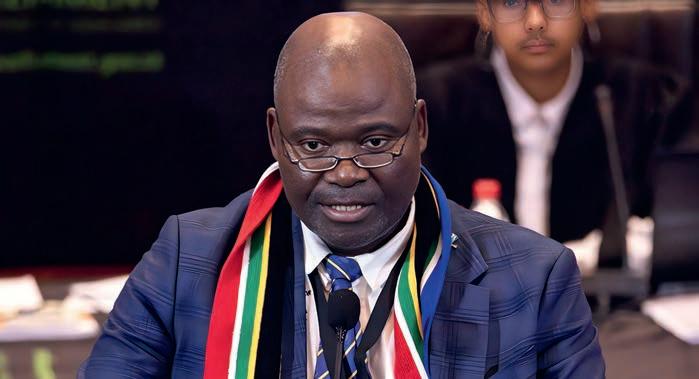
“This review is not merely another policy exercise; it is a pivotal moment
that will profoundly influence the future of economic development, service delivery and local governance in our nation.”– Bheki Stofile
municipal institutions.” The deputy minister suggests that today it is clear some of the policy assumptions made at that time were inaccurate and there is a need to take a step back and see which ones need to be revised.
Like Dr Masemola, Sto le acknowledges that some 1998 white paper assumptions were misplaced. He observes that the 1998 document “operated under the presumption that the economy was expanding, employment opportunities were expanding and municipalities were able to generate more local revenue”. He adds: “Nevertheless, the reality has changed signi cantly. In contrast to sustained economic growth, we have encountered an increasing scal crisis within the local government, as well as economic stagnation and rising unemployment. The expectation of self-suf cient municipalities has not been realised. Many municipalities cannot deliver even basic services, let alone realise their developmental potential, due to funding shortfalls.”
Faced with this discrepancy between the assumptions of the 1998 document and the harsh economic reality of today, the revision exercise became inevitable.
Dr Masemola says central to the challenges with the current system and policy framework is the fragmentation between the various spheres of government mandated to serve the people of South Africa because the laws at the time of the establishment of the white paper did not envisage certain scenarios. Due to this, he says: “There is a need for a new legal dispensation on how to make sure that this [inadequate legal framework] does not completely collapse municipal systems.” He refers to the dysfunction in cities like Johannesburg and Tshwane where some services have collapsed because of administrations that have been changing too regularly. Therefore, Dr Masemola suggests that within such a context it is no longer possible to “continue without the legal reforms that will respond to the challenges of the moment”.

Sto le supports the idea that the legal framework is central to the envisaged changes in the white paper. He says: “Complex laws and excessive regulation sti e creativity at the local level. The legislative framework must be streamlined to remove bureaucratic barriers that prevent municipalities from providing services effectively and innovatively.”
Sto le presented the other elements of the white paper that will be the focus of the revisions. These include introducing a new scal framework, ensuring all three levels of government work together to support local authorities, resolving the ambiguities and con icts that currently exist and hinder municipalities from carrying out their mandates, increasing local government capacity through skills development and encouraging ethical leadership, ghting corruption, and capacitating local government to tackle global issues such as the energy transition.
Will the reforms envisaged be adequate to reverse citizens’ understandable mistrust of the people running their municipalities?
Sto le believes the revisions will be adequate. However, he has a proviso: “Adequate funding, policies and political will are required from both the national and provincial governments to support these reforms. To guarantee that local government is sustainable, accountable and responsive to the needs of all South Africans, civic organisations, council members and municipal of cials must all participate actively and share a common goal.”
Dr Masemola is con dent the review process will be adequate. He says: “By the time we nalise the process, we are more than very sure that we are setting a policy whose horizon will go beyond thirty years because at least we are more clever now, more intelligent, more informed, more experienced ... than when we started in 1998.”
In its submission to the white paper review, the Good Governance Learning Network, an initiative bringing together civil society organisations working in the eld of local governance in South Africa to network towards the goal of promoting good governance, suggests more needs to be done. It advises: “The limited interpretation of the service delivery mandate of local government needs to be broadened. The role of municipalities in service delivery goes beyond merely the delivery of basic household services and infrastructure. Municipalities also need to concentrate on building sustainable human settlements that include access to social facilities (for example, parks, recreational facilities, public spaces, schools and clinics) and economic services.”
“When the 1998 white paper was adopted, it was very early in the establishment of the local government system, particularly concerning the integration of what used to exist then as town councils and other areas in the country.” – Dr Dickson Masemola
Debt. Corruption. Service delivery failures. These are just some of the challenges municipalities across South Africa face. With the local government funding model under review, the debate intensifies: will it lead to real change or just more bureaucracy, asks MARCHELLE ABRAHAMS
Municipalities across South Africa are buckling under financial strain, failing infrastructure and mismanagement. According to GroundUp, some municipalities are even overextracting water from dams without oversight. Water governance specialist Carin Bosman highlights a “big accountability gap” as authorities fail to track water usage effectively.
The Greater Tzaneen Municipality recently faced a court order that could have cut power to thousands of residents. While authorities reassured communities they would “do their best” to keep the lights on, such crises underscore the dire state of local government.
President Cyril Ramaphosa’s recent announcement of a review of the local government funding model during his State of the Nation Address (SONA) has been met with both hope and scepticism. But will this review address the real issues?
For years, the South African Local Government Association (SALGA) has lobbied National Treasury to review the Local Government Fiscal Framework.
According to Lerato Phasha, SALGA’s portfolio head of municipal nance, municipalities have long argued that the existing funding model does not re ect their economic realities.
“Municipalities have been raising challenges with SALGA that one of the nance challenges was a result of how local government is funded because the assumptions and aspirations of the White Paper on Local Government were not re ective of the realities of municipalities in the country,” explains Phasha.
Dawie Roodt, chief economist of the Ef cient Group, has long been critical of national government’s approach to economic growth and is blunt in his assessment: municipalities can’t collect
While many municipalities struggle, Midvaal in the Sedibeng District Municipality in Gauteng has consistently achieved clean audits, demonstrating that good governance is possible.
their local taxes suf ciently and corruption is rife. He criticises the idea of introducing additional local taxes, arguing that South Africa is already overtaxed. Instead, he believes municipalities must improve ef ciency and manage existing resources better.

However, Roodt is not optimistic about the funding review. “Municipalities can’t even implement the current system properly. Now they want to
“Metros and secondary cities are becoming more grant-dependent, while rural municipalities have little revenue-raising capacity.” – Lerato Phasha

One of the biggest barriers to municipal success is corruption. SALGA’s proposed reforms include strict accountability policies and consequences for those who breach them, whether politically or administratively.
complicate it further. There’s no way they’ll be able to manage this,” he warns.
Long before Ramaphosa’s announcement, Dr Lindokuhle Manuel and Professor Lourens Erasmus conducted a study proposing a sustainable differentiated funding model for South African district municipalities. Their research found that funding allocations often fail to align with constitutional mandates, leaving many municipalities nancially distressed.
They argue that a “one-size- ts-all” approach is awed, recommending municipalities be funded based on their unique geographical and economic circumstances rather than a blanket formula.

On the other hand, the National Treasury says the issues cited, such as nonpayment of municipal bills, are not problems with the scal model (local government scal framework) per se. “Rather, they are indicative of a lack of prudent nancial management, which leads to poor budgeting, overexpenditure and revenue management practices,” notes National Treasury of cial Ogalaletseng Gaarekwe, acting deputy director-general of intergovernmental relations.




While many municipalities struggle, Midvaal in the


Sedibeng District Municipality in Gauteng has consistently achieved clean audits, demonstrating that good governance is possible. It’s the only municipality in Gauteng to achieve this status for 10 consecutive years. Executive mayor Peter Texerira credits this success to strict hiring policies, accountability and nancial discipline.
“There’s a very strong culture in the municipality of good governance and sound management in terms of our nances, but mayors can only be as good as the administration they appoint in the municipality,” says Texerira.
A strong advocate for employing individuals who get the job done, he says Midvaal does not compromise on the quali cations of municipal staff. “We are very strict on that. If you are in the engineering or infrastructure department, there are certain quali cations that you need to have to be appointed.”
Texerira believes this method sets his municipality apart from others. That “and a very strong system of accountability”. Talking about transparency, he says his department has zero tolerance for corruption.
One can argue that a municipality with a population of about 125 000 and 38 000 registered households is an easy undertaking compared to a larger metropolis. Nonetheless, Midvaal must be doing something exceptional. About 90 per cent of municipal debts are collected, exceeding the national average. It plans to address the unemployment issue head-on by attracting investment.
Texerira has prioritised attracting investment and allocated empty municipal land along the R56. He’s made an appealing case for the agriculture sector by marketing Midvaal as Gauteng’s food basket.
Midvaal is run collaboratively by the political of ce, led by Texerira, while the administrative of ce is overseen by the municipal manager. Texerira is very clear that he doesn’t interfere with the administrative side of things.
“We’ve created a conducive and enabling environment for our employees to showcase their talents as public servants,” he says, adding that his of ce is just getting the basics done. “It’s not rocket science.”
Could this be where struggling municipalities are going wrong? He concurs that often the roles between politicians and administrators are blurred. Texerira Is honest about his misgivings of the current funding model. Echoing Dr Manuel and Prof Erasmus’s recommendations, he says: “I think it’s quite problematic in a sense that there’s a blanket approach.” He explains that municipalities with a good track record are disadvantaged.
Municipalities are funded based on population, grant funding allocation and equitable share. It puts a massive strain on the existing infrastructure because people migrate to better-run regions.
“The equitable share in terms of the funding model does not make provision for that, so I feel municipalities that are spending their grant funding well should obviously be given a bigger budget,” Texerira explains.

Like Texerira, Phasha explains the original funding model, implemented in 1998, is outdated and does not account for the evolving nancial needs of municipalities. “Metros and secondary cities are becoming more grant-dependent, while rural municipalities have little revenue-raising capacity,” she says.
SALGA’s solution is for the revised framework to re ect current realities such as revenue and expenditure trends (preferably last 10 years), socioeconomic issues, economic growth, unfunded and underfunded mandates and inef ciencies of the local government and also of the other spheres of government.
About alternative funding sources, Gaarekwe says municipalities have access to several alternative sources to help diversify their revenue. She uses examples such as local business tax, pooled nancing mechanisms and carbon pricing. “These funding sources should, however, be carefully considered and weighed up against the broader macro factors and infrastructure that requires substantial funding.”
One of the biggest barriers to municipal success is corruption. SALGA’s proposed reforms include strict accountability policies and consequences for those who breach them, whether politically or administratively. “We need policies that actually hold people accountable, with real consequences,” Phasha insists.
Local government receives only 9.6 per cent of the national budget for the 2024/25 scal year, a gure SALGA argues is inadequate.


The success of any funding model review depends on political will, improved governance and nancial discipline at municipal level. While reform is necessary, it will mean little if municipalities continue to struggle with corruption and inef ciency. The challenge remains: can South Africa’s local government be xed before more municipalities collapse?
“There’s a very strong culture in the municipality of good governance and sound management in terms of our finances, but mayors can only be as good as the administration they appoint in the municipality.” – Peter Texerira
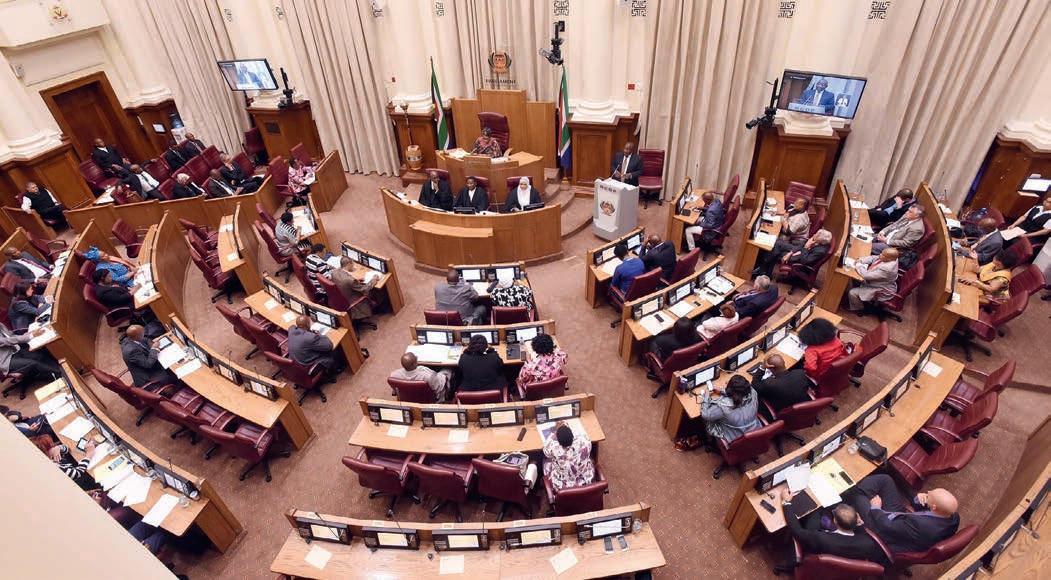
To solve the leadership challenges in South African local government, it is vital to look beyond policy and accept that ethical leadership, a community-centred approach and consequences for bad behaviour play a key role, writes BUSANI MOYO
When President Cyril Ramaphosa delivered his latest State of the Nation Address (SONA) on 6 February 2025, it was clear that he was acutely aware of the challenges facing South African municipalities. It is also clear that he knows the genesis of the problems: “… many municipalities lack the technical skills and resources required to meet people’s needs”. He promised South Africans: “Starting this year, we will work with our municipalities to establish professionally managed, ringfenced utilities for water and electricity services to ensure there is adequate investment and maintenance.”
While policy reforms such as those announced in the SONA are crucial, their success depends on leadership at the municipal level. We explore the human factor – mayors, councillors and municipal managers who must implement change –and identify the challenges and solutions. The main question is clear: do we have
the leadership to ensure the president’s promises are ful lled?
That South Africa needs local government reform is no longer disputed. In the same vein, there is no dispute that the challenges faced by municipalities are related to leadership de ciencies. But what are these challenges?
South African Local Government Association (SALGA) president Bheki Sto le has the answer: “Municipalities are currently confronted with substantial obstacles. They are confronted with signi cant nancial de cits, inadequate service delivery and deteriorating infrastructure.” He doesn’t sugarcoat the situation: “The system, which was initially designed to enhance communities, is currently on the brink of collapse.”
Kris Dobie is the senior manager of organisational ethics at the Ethics Institute, a Pretoria-based independent public institute that produces original thought leadership, services and products related to organisational ethics. He says the Ethics Institute approached the Department of Cooperative Governance and Traditional Affairs (CoGTA) and SALGA in 2020 “to work on the development of a code for ethical leadership within local government”, and the idea was accepted. Within this context, the Ethics Institute came to understand the depth of the leadership challenges in South African local government.
Dobie says they keep hearing one thing during their outreach programmes across South Africa: “We are not going to solve the challenges at local government without dealing with the ethical leadership challenges.” He adds this knowledge informed them that the foundation for proper leadership in municipalities lies in addressing the human factor and understanding why the people employed to serve South Africans at the local government level fail to do
“We are not going to solve the challenges at local government without dealing with the ethical leadership challenges.” – Kris Dobie
so as expected. This research would then culminate in the development of a code for ethical leadership within local government. According to Dobie, this was a collaborative effort by SALGA, CoGTA, the Moral Regeneration Movement and the Ethics Institute. Central to the initiatives of this collaboration was research on what makes ethical leadership dif cult in local government.
Deputy Minister of CoGTA Dr Dickson Masemola is also clear about the basis of the leadership challenges: “issues of malfeasance and corruption”. The deputy minister adds that it is vital to take action before the municipal systems collapse altogether. He says a dearth of leadership impacts the “overall perception of societies of municipalities, the overall con dence of the system and economic development of areas”. Dr Masemola says the consequences are real when this happens: “Some municipalities have lost investment, which leaves people unemployed.”
If policy alone has not produced desirable results in the last 30 years, what more must be done? Dobie says that from their research, they concluded that while traditionally, the idea is to put in place controls like policies, procedures, laws and regulations “that on its own is insuf cient, we also need soft controls” by focusing on the “culture within which things take place”. He adds: “It doesn’t help that you put in place laws to follow due process to appoint the right people if people do not want to do that as they are going to nd ways around those rules.”
In his speech at the launch of the 1998 White Paper on Local Government review on 11 March 2025 at the Taj Cape Town, Sto le clearly stated what needs to be done: “There is a need to greatly increase local government’s capacity. To raise performance and governance standards, this improvement should place a higher priority on professionalising local government, developing skills and exercising ethical leadership. For local governments to successfully carry out their developmental responsibilities, local government must develop into a competent and professional organisation.”
“The idea of accountability ought to be unassailable to hold people accountable for failing to fulfil their obligations.” – Bheki Stofile
Sto le also spoke about inculcating ethical behaviour and ghting corruption as central solutions to the accountability challenge in local government. He admitted: “Local government has long been beset by corruption and poor management.” The SALGA president believes that to solve many leadership challenges facing South African local government, “the idea of accountability ought to be unassailable to hold people accountable for failing to ful l their obligations”.
Within the context of determining what can be done beyond policy, Dr Masemola warns: “There are certain things, which by word of mouth, coaching or mentoring cannot easily be dealt with because there are cultural things deeply inherent in our system and they must be uprooted.” He believes the focus on solving challenges should be centred on the law, which must “bite and be clear about the criminalisation of gross glaring nancial deliberate mismanagement”. He argues: “Talking has been done, but the challenges continue. Until the law becomes rm and strict and people know that if I cross this line, I don’t have to ask for forgiveness, these are the likely consequences.”
Sto le reminds everyone why municipalities need the right and accountable leaders. “The future of our democracy and the standard of living for millions of South Africans will be determined by how well the local government performs.” He is clear about what needs to be done: “It is time to take decisive action. The time has come to act with foresight, bravery and a strong sense of duty.
“By working together, we can revolutionise local government and create a future where towns are hubs for sustainable development, growth and high-quality services,” Sto le concludes.
CoGTA, SALGA, The Ethics Institute and the Moral Regeneration Movement have established a Code for Ethical Leadership in local government, which shows how South Africa can go beyond policy in dealing with the leadership challenge in local government.
The code stipulates:
•Set out the tone for an ethical culture.
• Follow a community-centred approach to governance.
• Respect the boundary between the political and administrative spheres of the municipality.
• Ensure the appointment of staff with competence and integrity.
• Ensure appropriate competence, integrity and diversity on committees and oversight structures.
• Deal fairly and decisively with ethical transgressions and poor performance.
• Engage respectfully and constructively with other leaders. The parties involved in developing this code state in the document that the leadership challenges in local government in South Africa can be solved if political parties “continuously emphasise the importance of setting the tone and that ethical leadership should be the non-negotiable ‘way’ in which they lead”. They add: “Ethical leadership should be the core focus of training conducted by parties.”
Follow: Kris Dobie www.linkedin.com/in/kris-dobie-b5440015 Dr Dickson Masemola https://x.com/masemoladickson?lang=en SALGA www.instagram.com/salga.org.za/p/DCEKuLNNloS/?img_index=1
MONEI SELEHO, head of public sector, and PULENG KHUNOU, divisional executive public sector at Nedbank Commercial Banking, discuss how targeted investments, public-private partnerships and financial stability can drive municipal transformation
While South Africa has made strides in providing essential services, signi cant challenges remain, particularly in municipalities struggling with nancial stability and infrastructure de cits.
The quality of infrastructure – roads, ports, telecommunications and utilities – plays a critical role in attracting investment and improving the quality of life. At municipal level, infrastructure development is essential for enhancing service delivery and fostering decentralised economic growth.
Municipalities have the potential to drive economic progress, but this requires well-managed local governance. Effective service delivery, nancial stability and infrastructure development are key to creating environments that attract investment and generate jobs.
Improving basic services is crucial for achieving the Sustainable Development Goals (SDGs) outlined in South Africa’s National Development Plan Vision 2030. Encouragingly, the 2023 General Household Survey by Stats SA indicates some progress in service provision, particularly in urban and rural areas. However, much remains to be done, especially in municipalities struggling with service delivery backlogs.
Many local governments face challenges in revenue collection, nancial mismanagement and underinvestment in infrastructure. Without a solid nancial foundation – supported by ef cient revenue collection and reduced nancial leakages – municipalities cannot provide essential services effectively, let alone invest in infrastructure development.
Strategic infrastructure investments, particularly in roads, sanitation, water and energy, have far-reaching economic bene ts. A well-maintained road network lowers transport costs for businesses, while improved water and sanitation infrastructure supports public health and enhances living conditions.
Despite the availability of government grants, many municipalities struggle to utilise infrastructure funding effectively. National Treasury’s report on municipal spending in the second quarter of the 2023/24 nancial year highlights concerning trends of underspending on infrastructure grants. Strengthening nancial and project management capacity is essential to ensure funds are allocated and utilised ef ciently.
The increasing threat of climate change makes infrastructure investment even more urgent. Municipalities must prioritise water security and renewable energy projects to prevent future crises. Investing in water infrastructure – through rehabilitation of existing systems or capacity expansion –can help municipalities avoid the severe service disruptions currently affecting the energy sector.
Beyond immediate nancial returns, infrastructure investment enhances education, agriculture and healthcare outcomes, supporting long-term socioeconomic progress.
To bridge infrastructure funding gaps, municipalities must engage in public-private partnerships. Collaborating with the private sector enables municipalities to leverage expertise, secure funding and implement projects more ef ciently.
Financial institutions like Nedbank Commercial Banking play a vital role in supporting municipal infrastructure projects. Nedbank has structured debt facilities for various municipalities, including:
• Stellenbosch Municipality: bulk water supply, treatment and alternative energy projects.
• Mossel Bay Local Municipality: renewable energy, water and sewerage infrastructure.
• A leading South African metro: a term loan facility to fund capital expenditure projects, enhancing service delivery. Nedbank also continues to pursue funding opportunities in smart metering, renewable energy and water infrastructure as part of its green mandate.
Public-private collaboration does more than nance projects – it enhances municipalities’ attractiveness to local and international investors. Investment in municipal infrastructure creates jobs, strengthens local economies and helps decentralise growth. This, in turn, can curb migration to overburdened urban centres struggling with service delivery challenges.
As South Africa moves towards greater industrialisation, effective municipal governance is more important than ever. Prioritising skill development, nancial accountability and transparent governance will enable municipalities to break free from service delivery constraints and unlock sustainable growth.
By channelling resources into municipal infrastructure, South Africa can generate widespread economic bene ts, improve service delivery and support national development goals. Nedbank’s commitment to using its nancial expertise for good aligns with these objectives, reinforcing its role as a strategic partner in municipal transformation.









How does the lack of service delivery at municipalities throughout the country impact human rights?
By RYLAND FISHER
When President Cyril Ramaphosa met with Johannesburg’s municipal leadership recently, he pointed out to them the importance of service delivery ahead of the upcoming G20 Summit. He did not mention the lack of service delivery’s impact on the human rights of ordinary citizens, but he should have.
Ramaphosa said: “Johannesburg today faces enormous challenges, ranging from nancial and governance instability to rapidly deteriorating infrastructure. Water and electricity interruptions have become the norm. This has an enormous impact on the quality of life of citizens and the operations of businesses. The road infrastructure faces tremendous challenges. These include vandalism of traf c lights, dysfunctional street lights and rapidly deteriorating roads and bridges.
“As national government, we understand the constraints faced by the city and appreciate the leadership shown by the executive mayor and his executive to stabilise governance and nancial management. Without these critical levers, service delivery will not improve.”
Ramaphosa pointed out that “many of the challenges currently faced by the City of Johannesburg are similar to challenges
faced by other metros”. But the reality is that none of the other metros or local municipalities have seen the president step in to ensure they improve service delivery for their residents.
Chapter Two of the South African Constitution, the Bill of Rights, guarantees that everyone has the right to adequate housing, basic and further education and access to “healthcare services, including reproductive healthcare, suf cient food and water and social security, including, if they are unable to support themselves and their dependants, appropriate social assistance”.
The Water Services Act of 1997 was passed to ensure that everyone has access to basic water and sanitation.
“The state,” says the Bill of Rights, “must take reasonable legislative and other measures, within its available resources, to achieve the progressive realisation of each of these rights.” The lack of proper water supply and electricity in the City of Johannesburg is a clear violation of human rights as enshrined in the Constitution.
In November last year, the South African Human Rights Commission (SAHRC) released a disturbing report of its inquiry into service delivery at local government level in the Free State province.
This followed a high number of complaints regarding the lack of access to water, electricity, housing, sanitation and refuse collection. The report dealt with service delivery issues in 18 local municipalities as well as the Mangaung Metropolitan Municipality, the Free State Department of Water and Sanitation and the Free State Department of Cooperative Governance and Traditional Affairs.
It detailed a litany of problems, including high-level vacancies at both technical and management levels at municipalities, which often led to service delivery problems, including poor infrastructure maintenance, poor road infrastructure, poor or weak refuse removal services and challenges of revenue collection that threaten the nancial viability of municipalities.
The report found that some municipalities violate section 27(1)(b) of the Constitution
“Johannesburg today faces enormous challenges, ranging from financial and governance instability to rapidly deteriorating infrastructure. Water and electricity interruptions have become the norm.” – President Cyril Ramaphosa
and regulations 2, 3 and 4 of the regulations relating to compulsory national standards and measures to conserve water. Another nding is that some local municipalities in the Free State Province have high levels of indebtedness to Eskom and water boards. Challenges of vandalism, theft and unlawful connections to water and electricity networks and the prevalence of the bucket toilet system are some of the ndings contained in the report.
The report made several recommendations to x these problems and gave the municipalities and government departments three months to come up with their individual plans. More than four months later, it is not clear whether any such plans have been delivered.
There have not been many cases of municipalities or government departments being taken to court successfully. One
such case was Rademan vs Moqhaka Municipality, which hinges on a resident refusing to pay rates on the grounds of a lack of service delivery. The municipality cut the resident’s electricity supply, which led to a series of court cases, resulting in a Constitutional Court decision.
While the Constitutional Court found in favour of the municipality, the Helen Suzman Foundation warned this does not mean that municipalities can willy-nilly cut off residents’ power supply.
Part of the judgement, written by Judge Zondo, said: “Where a municipality claims payment from a resident or ratepayer for services, it is only entitled to payment for services that it has rendered. By the same token, where a municipality claims from a resident, customer or ratepayer payment for services, the resident, customer or ratepayer is only obliged to pay the municipality for
services that have been rendered. There is no obligation on a resident, customer or ratepayer to pay the municipality for a service that has not been rendered.”
The Organisation Undoing Tax Abuse (OUTA) argues that proper consultation is one way of holding municipalities to account for service delivery.
“Public participation is crucial in building an effective, inclusive and representative democracy. Citizens have the right to meaningful consultation and engagement with local government. The administration has an obligation to communicate and publicise its activities, giving the citizens ample time for consultation and feedback, prior to the council making decisions. Inputs from the community must be re ected in council resolutions. The power lies with the people,” OUTA said in an opinion piece on its website.

South Africa’s youth demand a seat at the table, writes WELLINGTON RADU, regional head of programmes: Southern Africa at Futurelect, a nonprofit organisation dedicated to civic education and leadership development

While South Africa has made remarkable progress in strengthening its democracy, a critical challenge persists: mobilising youth civic participation. Recent statistics paint a stark picture, with only 36 per cent of voters aged 18–19 years and 58 per cent of voters aged 20–29 years participating in the May 2024 South African national elections. This concerning trend, however, doesn’t reflect apathy but highlights disillusionment, disenfranchisement and systemic gaps in access to civic knowledge and opportunities to engage.
ASeptember 2024 survey by Statista revealed that 60 per cent of South Africans believe the country is heading in the wrong direction, mirroring growing dissatisfaction. Yet, young South Africans desire to make a difference, have their voices heard and shape the nation’s future. We know this because young people form the majority of the protests taking place in the country almost daily. However, they need support to equip them with the tools to engage effectively and meaningfully.
THE YOUTH WANT TO MAKE A DIFFERENCE: THE ROLE OF CIVIC EDUCATION
South Africa’s youth are eager to participate. You see this by looking at the number of young people participating in the service delivery protests we witness almost daily in different parts of the country. Yet, protesting is not the only way to get your voice heard. There are many other ways the youth can fully participate in our democracy, which is the mainstay of our civic engagement efforts.
Without a deeper understanding of democratic mechanisms, many young people feel excluded from processes directly impacting their lives. Civic education serves as a powerful tool to bridge this gap by:
• Empowering informed decision-making.
• Inspiring con dence to hold leaders accountable.
• Building meaningful participation in governance.
Through initiatives such as Futurelect’s widely accessible online Civic Education Programme, youth aged 16–34 learn how democracy works, how to navigate political systems and how to advocate for change effectively.
Young South Africans face additional hurdles that civic education can help address. For instance, inef ciencies in the National Student Financial Aid Scheme (NSFAS) – which disbursed R47-billion in 2023 to support over 1.2 million students – often leave learners struggling. Administrative delays require skilled and informed advocacy to ensure policies function as intended.
Similarly, access to quality education remains a challenge for millions. According to UNESCO, 34 million children in Central, East, Southern and West Africa remain out of school. Civic education enables young
people to address such systemic barriers, advocating for solutions that ensure future generations thrive.
Far from being indifferent, South Africa’s youth are ready to shape the nation’s democratic and developmental trajectory.
• They want their voices heard. Active youth participation can transform governance systems from local communities to the national stage.
• They seek accountable leadership. Civic education helps young voters elect representatives who prioritise youth-centric policies.
• They demand reform. Advocacy and participation can drive meaningful change, ensuring accountability in institutions such as NSFAS. For democracy to thrive, the participation of young voices is not optional but essential. The youth have the drive to lead and advocate for solutions; we must ensure they have the knowledge and platforms to do so. As we look forward to the upcoming local government elections in 2026, young people can use the knowledge from civic education not only to go out and vote, but also to hold their elected of cials accountable beyond the ballot.
Futurelect’s Civic Education Programme offers accessible, independently peer-reviewed courses on democracy and governance. Futurelect’s mobile learning app makes these resources readily available, ensuring no young person is left behind in shaping their future. For more information, contact Shaunei Gerber, head of marketing and communications at Futurelect, shaunei@futurelect.org or visit www.futurelect.org. Download the Futurelect learning app on iOS, Google Play and Huawei.

South Africa’s deepening water crisis is a growing concern for households, businesses and investors. Across municipalities, ageing infrastructure, illegal connections and vandalism continue to drain billions while communities struggle with supply shortages, writes ITUMELENG MOGAKI
Widely reported gures show that Gauteng municipalities spent over R2.367-billion on water tankers between 2018 and 2023, highlighting service delivery challenges. In the Free State, municipalities lost R3.756-billion in potential revenue over seven years due to leaks and outdated infrastructure, with some areas losing over 90 per cent of their billable water.
The situation is equally dire in Limpopo, where the R20-million Mashau Doli water project has failed to provide reliable access to 700 rural households. Klerksdorp, in the North West province, continues to face severe shortages due to deteriorating supply systems, further crippling the once-thriving mining and agricultural hub.
Meanwhile, investors are sounding the alarm, with Coronation’s latest report warning that water security is one of the most critical risks to South Africa’s (SA) long-term economic stability.
Finance Minister Enoch Godongwana, in his 2025 Budget speech, emphasised investment in water infrastructure, including the uMkhomazi Project, which is set to begin construction in November 2027 and will expand the uMngeni water supply system to serve ve million households in eThekwini and four district municipalities in KwaZulu-Natal.
However, with municipalities still facing massive water losses and nancial strain, urgent interventions are needed to prevent further collapse.
The South African Infrastructure Fund’s R36-billion blended nance model aims to leverage public funds to attract private investment in infrastructure projects, addressing market failures
and improving project bankability by combining public and private funding. The Infrastructure Fund will support major projects including the Polihali Dam, a concrete-faced rock ll dam, a critical component of the Lesotho Highlands Water Project (LHWP) Phase II, designed to increase water supply to SA and enhance hydropower generation in Lesotho, with a reservoir capacity of 2.325 billion cubic metres.
We spoke to industry experts for insights on water security and availability challenges and how local municipalities can pursue sustainable solutions.
Asked about the role outdated infrastructure plays in SA’s water crisis, Lubabalo Luyaba, South African Local Government’s (SALGA) water and sanitation specialist, says the main issue is not necessarily the age of the infrastructure but the lack of investment in maintaining it.
“In the 144 municipalities across the country, many face challenges not because their infrastructure is old, but because there has been insuf cient investment in its maintenance and upgrades. For instance, pipes that were supposed to last for thirty years may only last ten if they are neglected, leading to constant leaks and failures,” says Luyaba.
He says that when water services fail, the fundamental purpose of water – to support daily life and economic
activity – is undermined. “Communities, particularly those that cannot afford to buy water, are left stranded, and businesses that rely on a constant water supply may be forced to shut down.”
Drawing attention to the Dundee water crisis as an example of how community action can highlight critical water and sanitation challenges, Luyaba says water and sanitation challenges should not have to be resolved through court action, as seen in the case of the Endumeni Civic Association. “The real issue is the lack of adequate engagement and the shortage of funds.”

In some cases, municipalities fail to respond effectively to community concerns, leading to breakdowns in the relationship between citizens and local governments. “If communities are resorting to protests or legal action, it indicates a failure in the system to meet their needs,” says Luyaba.
He also mentions another challenge regarding how water is consumed without being paid for, often due to illegal connections or theft. “These losses, while commercial in nature, can signi cantly impact municipalities’ ability to provide consistent water services to legitimate consumers.”
In addition to governmental efforts, Luyaba says citizens have a vital role in reducing water wastage by using it
“When water services fail, the fundamental purpose of water – to support daily life and economic activity – is undermined.” – Lubabalo Luyaba
conservatively. He encourages residents to report illegal connections or leaks promptly to ensure resources are used ef ciently and equitably.
Even though the government has committed to addressing water infrastructure challenges through various funding initiatives, including the R36-billion Infrastructure Fund, Luyaba questions the adequacy of this investment. “Joburg alone reports needing R26-billion to address its water and sanitation challenges, which means R36-billion is far from enough.”
While SALGA has not yet engaged directly with the Infrastructure Fund, Luyaba remains optimistic that collaboration will lead to effective solutions. “Every cent counts and working through the National Water Partnership Of ce can help us maximise the impact of this funding,” he says.
Luyaba highlights the signi cance of the Polihali Dam, a key project to ensure long-term water security for SA. “The Polihali Dam is crucial for the Vaal River system, which supplies Gauteng, but we must remember that water security for all eight provinces is equally important.”
Dean Muruven, associate director at Boston Consulting Group, says access to water is more politically charged than access to electricity. “It is a fundamental right, enshrined in the Bill of Rights, which states that everyone has the right to suf cient food and water. This brings land reform into the discussion, a topic already fraught with emotion.”

Muruven continues: “Then there is the question of democratising access to water infrastructure. One of the key learnings from the energy crisis was that individuals or businesses with the nancial means to invest in solar solutions could enjoy a better quality of life compared with those who couldn’t.”
Muruven adds that the apartheid era is still a signi cant factor in how water is supplied and distributed in different parts of the country. “For example, from a governance perspective, municipalities in the Western Cape outperform those in most other provinces. Without detracting from this, we must remember that the Western Cape has no history of homelands.
“After 1994, people living in homelands, who had received minimal municipal services, had to be brought into the system. The point is building a resilient water system in South Africa must be accompanied by creating social resilience. Without considering this perspective, we risk continuing to design systems for people instead of with them, which will not yield the desired results,” he says.
Muruven says to realise blended nance to attract private investment into the water sector, governments must send effective market signals by pricing water correctly. “Given that water is a human right, it should be inexpensive, but people should also have an incentive to conserve it.”
Jay Bhagwan of the International Water Association says global examples of cities transitioning to water reuse offer hope that reclamation (converting municipal and industrial wastewater into reusable water for several purposes) will be a key part of the future.
He gives the example of Windhoek, Namibia, one of the world’s most successful cases of direct potable water reuse. “Since the 1960s, Windhoek

has been a pioneer in this space, with the New Goreangab Wastewater Reclamation Plant supplying up to 25 000 kilolitres of drinking water daily, covering about 35 per cent of the city’s needs.”
He says Cape Town is positioning itself as a global leader in water reuse, with the Faure New Water Scheme, a permanent reuse facility, now in the planning and design phase and set to become one of the largest in the world. “Under Cape Town’s water strategy, the city aims to increase supply by 300 megalitres per day by 2030, with water reuse playing a critical role. The Faure scheme’s rst phase will provide 70 megalitres per day, eventually scaling up to 100 megalitres daily. This commitment to water reuse marks a signi cant step toward long-term water security and serves as a model for other cities facing similar challenges.”
Luyaba calls for a holistic approach to water and sanitation challenges, emphasising the importance of maintaining existing infrastructure, investing in new projects and engaging citizens in conservation efforts. “The water crisis is not something that can be solved overnight, but with co-ordinated efforts, we can work towards a more sustainable future,” he says.
Follow: Lubabalo Luyaba https://www.linkedin.com/in/lubabalo-luyaba-1276b844
Dean Muruven BCG https://www.bcg.com/about/people/experts/dean-muruven
Jay Bhagwan https://www.linkedin.com/in/jay-bhagwan-11555215


39 Murray Park Library in Malvern, Johannesburg gets an upgrade; Matholesville Multipurpose Centre – a new state-of-the-art facility being developed in Ward 27; Nonmotorised transport – building infrastructure for people.
42 The National Communicators Forum. “Communication is critical in local government because it is so close to the people and the heartbeat of the people. We need to be very sure what our residents want in local government for us to actually deliver the service.” – Kouga Municipality executive mayor Hattingh Bornman.
44 Municipal Best Practice Conference: exploring fiscal governance, institutional practices and leadership in municipal finance.
“With fiscal governance remaining a top priority, SALGA and its partners aim to continue fostering a collaborative environment where municipal finance professionals can exchange knowledge, refine financial policies and drive the long-term sustainability of South Africa’s municipalities.” – Lerato Phasha, SALGA’s portfolio head for municipal finance.


www.businessmediamags.co.za








ADVERTISING CONTACT
Jerome Van Der Merwe Sales Project Manager
Cell: +27(0) 82 668 1496
Email: jeromem@picasso.co.za
PUBLISHER
PICASSO HEADLINE, a proud division of ARENA HOLDINGS (PTY) Ltd Hill on Empire 16 Empire Road (cnr Hillside Road), Parktown, Johannesburg

The Johannesburg Development Agency, on behalf of the City of Johannesburg’s Community Development Department, has commenced the construction of the long-awaited upgrades to the Murray Park Library in Malvern, Johannesburg

First opened in 1957, Murray Park Library has been a cornerstone of knowledge and community engagement for over six decades. Recognising its importance as a hub for education and enrichment, the Johannesburg Development Agency (JDA) spearheads a comprehensive redevelopment project to modernise and revitalise this beloved institution.
The upgrade of Murray Park Library is part of the Inner City Eastern Gateway Urban Development Framework, re ecting the city’s commitment to enhancing infrastructure and services for its residents. Upon completion, the renovated library will serve as a beacon of learning and culture for Malvern and surrounding communities.

The Murray Park Library upgrade project will be in two phases, with phase one focusing on
foundational elements and phase two concentrating on constructing the two-storey library structure.
Phase one is scheduled for implementation in the 2024/2025 financial year. It encompasses critical groundwork such as site clearance, construction of retaining walls and foundational preparations.
Phase two will see the construction of the state-of-the-art library facility, spanning approximately 2 000m2.
The ground floor will feature a general library space, a study
The upgraded Murray Park Library will serve as a dynamic community resource, offering world-class library and information services to residents of all ages. From providing access to literature and educational resources to fostering a vibrant space for cultural exchange and lifelong learning, the new library will enrich the lives of a diverse population.

“We are excited to revitalise Murray Park Library, a cherished landmark that has served our community for over six decades,” says Siyabonga Genu, JDA executive manager: project implementation.
“This project underscores our commitment to creating inclusive spaces that foster lifelong learning, cultural enrichment and community cohesion. Through thoughtful design and meticulous planning, we aim to deliver a modern, accessible library facility that will be a source of pride for generations to come,” he concludes.
area for children, meeting rooms, a study centre and essential amenities.
The first floor will accommodate a teenage section, activity centre, e-learning area and additional facilities. The exterior enhancements include landscaping, paving, lighting and parking facilities.
The upgrade project emphasises sustainability and accessibility, with provisions for solar panels, upgraded power supply capacity and facilities for persons with disabilities.
The 1 800m2 Matholesville Multipurpose Centre is part of the City of Johannesburg’s strategy to meet the demand for new social infrastructure. The Johannesburg Development Agency is implementing the construction of the state-of-the-art facility in Ward 127, Region C
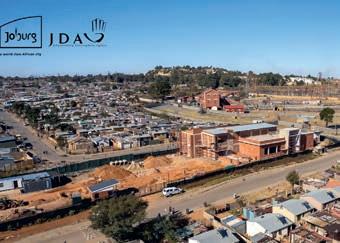
The Matholesville Multipurpose Centre will provide a safe space that facilitates the development of fundamental skills, such as reading and writing, in conjunction with sport, physical activity and health to stimulate growth and development in the community.
The clustering of social facilities represents a key strategy in providing a basis for growth and densi cation. The multipurpose centre will include a much-needed library and computer room, community hall, creche, sports facilities, swimming pool and of ces.
Located on the corner of Randfontein Road (R41) and Mathews Goniwe Drive, the R48-million project is being implemented on behalf of the City of Johannesburg’s Community Development Department in three phases.

As the infrastructure arm of the City of Johannesburg, the Johannesburg
Development Agency (JDA) completed the rst phase, which entailed bulk earthworks to shape and prepare the land for construction and create a level foundation for the centre.
The rst phase also included the implementation of services, the installation of a site perimeter fence and the construction of a guardhouse.
Phase two of the project, currently at 85 per cent, entails the construction of a state-of-the-art library, parking facilities, stormwater infrastructure and electrical, mechanical, water and sewer connection services.
The Matholesville Library will be a crucial resource for local communities, providing a range of bene ts that promote education, social inclusion and economic development. The library will offer free access to books, educational materials and resources, supporting learning for people of all ages.
The facilities to be implemented as part of phase three will provide residents of Matholesville with an opportunity to participate in sport, physical activity and health to stimulate growth and development in the community. The nal phase two of the project will see the implementation of:
• Swimming pool and learners pool: the addition of a community pool will serve as a recreational and educational space for people of all ages. The pool will not only offer residents a place to swim and relax, but will also be instrumental in teaching water safety and swimming lessons, especially for children.
• Sports facilities: the construction of sports facilities will create
opportunities for youth and adult sports leagues, serving as a vital space for community bonding and the development of young talent.

The development of the Matholesville Multipurpose Centre will incorporate education for sustainable development initiatives. Rainwater will be harvested for landscape irrigation and refuse bin washing.
A recycling refuse area will be provided for handling various waste types. Wheelie bins will be used to separate glass, plastics and cardboard/paper recycling. Bicycle parking will also be provided for use by the building staff and patrons.
One of the key objectives of the JDA is to undertake the project using labour-intensive approaches to provide cost-effective short-term employment opportunities to unskilled and semi-skilled workers.
So far, ve local emerging subcontractors have been appointed for the execution of the portions of the works in the project. Other small, medium and micro enterprises will be onboarded as trades open up. These include painting, plumbing, waterproo ng, paving and external works.
“By creating spaces that foster education, physical activity and community engagement, we aim to empower residents and stimulate growth. Despite the challenges we’ve faced, we are committed to delivering a facility that will be a cornerstone for social and economic development in Matholesville and surrounding areas,” Themba Mathibe, JDA CEO, says.
The City of Johannesburg’s Transport Department is committed to improving its transportation systems in alignment with the agenda to make public transport and nonmotorised transport the mode of choice by 2040

As the infrastructure arm of the city, the Johannesburg Development Agency (JDA) plays a vital role in the development of quality nonmotorised transport (NMT) infrastructure, which is critical in facilitating safe and accessible NMT use and unlocking NMT’s potential to become a feasible and sustainable transport mode in the city.
NMT includes all forms of human-powered mobility such as walking, cycling, skateboarding, and other small-wheeled innovations. In cities, pedestrians and cyclists typically make up the largest share of NMT users.
NMT has been prioritised in urban areas to achieve multiple objectives, including reducing congestion, pollution and carbon emissions and improving safety, accessibility and quality of life.
In line with the City’s commitment to creating liveable, sustainable urban environments in which residents navigate safely and ef ciently using public and nonmotorised transport, the JDA is implementing the Tshepisong and Cosmo City NMT projects in Region C.
Cosmo City is Region C’s major development and has become a huge mixed-income development northwest of Joburg. The Cosmo City NMT project is aimed at improving NMT infrastructure for pedestrians and cyclists and the improvement of public transport facilities by:
• Providing adequate walkways.
• Providing adequate street lighting.
• Addressing localised stormwater issues.
• Providing universal access.
The project site is on South Africa Drive in Cosmo City, in Ward 100 of Region C of the City of Johannesburg. The area of the proposed works spans an approximate distance of 3.5km within the bounds of Malibongwe Drive and Russia Avenue. The scope of work includes the following:
• Construction of paved sidewalks.
• Construction of asphalt sidewalks.
• Construction of mini-bus laybys.
• Construction of bus stop shelters.
• Landscaping.
• General public environmental upgrades.
In line with the City’s Complete Streets approach, Tshepisong NMT aims to enhance pedestrian routes along roads connecting to and from the Tshepisong public transport facilities, ensuring they meet the necessary standards for safety and accessibility.
The location is in the residential suburb of Tshepisong, Ward 128 northwest of Soweto. The area of the proposed works spans mainly three roads – the R558 to the east, Kagiso Road to the west and the R41, which is just north of the Tshepisong area. The scope of works is for the construction of sidewalks and includes the following:
• Relocation, raising or lowering of existing services.
• Earthworks, layer works for new sidewalks.
• Installation of universal access ramps and pedestrian crossings.
• Remedial work to existing stormwater services where required.
• Provision and construction of block paved sidewalks.
• Construction of pre-cast kerbing as well as cast in-situ concrete edge beams and channels.
• Landscaping.
One of the key objectives of the JDA is to undertake the Cosmo City and Tshepisong NMT infrastructure projects using labour-intensive approaches to provide cost-effective short-term employment opportunities to unskilled and semi-skilled workers. Local emerging subcontractors have been appointed for the execution of portions of the works in the NMT infrastructure project.
“The Cosmo City and Tshepisong NMT infrastructure projects are an example of the city’s commitment to promoting high-quality public transport networks where NMT is a basic provision in all transport planning and infrastructure projects,” says JDA CEO Themba Mathibe.
“The projects align with the JDA’s objective to support the growth and development of strategic nodes into high-quality, investor-friendly and sustainable urban environments,” he explains.
Effective communication is the backbone of good governance, particularly at the local level where government is closest to the people. Experts stress that municipalities must prioritise direct engagement with residents, combat misinformation and ensure transparency to foster trust and accountability.
By MATTHEW HIRSCH

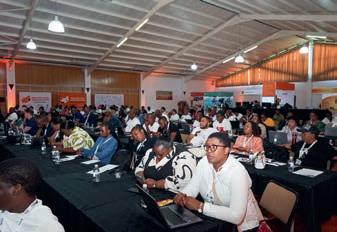


Local government operates at the frontline of service delivery, making communication an essential tool for engaging with communities. Kouga Municipality executive mayor Hattingh Bornman emphasises the importance of dialogue between municipalities and residents.
“Communication is critical in local government because it is so close to the people and the heartbeat of the people. We need to be very sure what our residents want in local government for us to actually deliver the service,” he says.
The increase in violent protests in municipalities across the country over the
past ve to eight years highlights the consequences of poor communication. Bornman says when municipalities fail to engage effectively, frustrations escalate. “If you do not have good communication, whether good or bad things to say, those kinds of incidents just increase dramatically. Being able to communicate what we can and cannot do from the municipality side is crucial.”



“Communication is critical in local government because it is so close to the people and the heartbeat of the people. We need to be very sure what our residents want in local government for us to actually deliver the service.” – Hattingh Bornman
Speaking at the recent South African Local Government Association (SALGA) National Communicators Forum, Bornman shared insights into how municipalities can improve communication. He emphasised the role of engagement in building a strong town brand identity and enhancing tourism. “It’s wonderful to be seen by the province and the country as one of the top municipalities as far as public participation is concerned,” he says, adding that their public participation team continuously nds new and innovative ways to communicate.
However, he acknowledges that traditional community meetings are no longer enough. While important, these gatherings must be supplemented by alternative communication platforms to reach broader audiences.
To enhance accessibility, Kouga Municipality has introduced social media as a key communication tool. “We also have extremely well-functioning WhatsApp groups. Every single ward has a municipal WhatsApp group, apart from the normal community WhatsApp groups. We’ve got thousands of people on those WhatsApp groups that we communicate with very effectively,” Bornman explains.
In addition, the municipality hosts First Thursday events, where residents can engage with the mayor, directors, municipal manager and relevant staff without prior appointments. “We’ve been using this platform for the last two years. It’s been effective in making us more accessible to our community. I think if you speak about communication, accessibility is a very key part of that.”
Beyond digital engagement, the municipality also relies on street meetings, ward committee meetings, print media, radio and podcasts. Several years ago, Bornman initiated the “15 Wards in 15 Days” campaign, visiting each ward to engage directly with residents and gather insights for budget planning.
“I like to be informed as much as possible when we go into our budget discussions for the new nancial year. I want to be there and see things for myself.
I want to speak to them and understand how they are feeling and what their needs are. It’s critical for a mayor to understand the broader community as well as possible,” he says.
This hands-on approach has led to tangible results, including R200-million set aside for road infrastructure projects.
Despite progress, municipalities face signi cant communication challenges. Legadima Leso, chief director of communications at Cooperative Governance and Traditional Affairs (CoGTA), points out that the effectiveness of municipal communication varies.
“In some municipalities, you are told that one person who is dealing with communication is an intern. In other municipalities, people who are not wanted somewhere are brought into the communication department. Unfortunately, when they get there, they are lost,” he says.
Leso stresses the need for municipalities to align their communication strategies with their Integrated Development Plans. Without a structured approach, many municipalities struggle to engage effectively with their communities.
In the digital era, misinformation spreads rapidly, making it crucial for municipalities to respond swiftly. Bornman highlights the importance of proactive communication. “If you don’t combat fake news with the truth as soon as possible and with a broad explanation of what the facts are, it becomes more and more dif cult to stop any rumours.”
Leso echoes this sentiment, noting that online and digital platforms often serve as breeding grounds for misinformation. “If you are not agile, if you do not respond rapidly, you face a situation where now your audiences start believing false information,” he says.
To counter misinformation, municipalities must ensure transparency and consistency in messaging. Bornman adds that even when municipalities have no updates to share, they should maintain open lines of communication. “It’s important to tell the truth, even if you have nothing to say, rather say ‘I don’t have anything to say on this issue.’ Even if it’s bad news … although we don’t get things done 100 per cent correct all the time, we’ve been working towards that.”
As municipalities strive to improve communication, platforms such as the SALGA National Communicators Forum play a pivotal role. The annual event brings together communicators from all 257 municipalities, fostering peer learning, problem-solving and recognition of excellence in municipal communication.
Leso observes that the forum inspires communicators to strive for excellence. “People need to know what government is doing to change their lives on the ground. When people are not aware that the road they are waiting for is coming, they end up protesting just because of a lack of information.”
A notable example of effective municipal communication is the City of Tshwane under the new mayor, Dr Nasiphi Moya. Leso commends the city for its proactive approach in bringing government closer to the people. Ultimately, local government communicators must be in sync with community needs, embrace multiple platforms and prioritise transparency to build trust. As municipalities continue to evolve, fostering a culture of open, two-way communication will remain key to effective governance and service delivery.
“If you are not agile, if you do not respond rapidly, you face a situation where now your audiences start believing false information.” – Legadima Leso
The Municipal Finance Path to Best Practice Conference, hosted by the South African Local Government Association, took place on 20–21 February 2025 at the Radisson Hotel OR Tambo in Johannesburg. ITUMELENG MOGAKI reports on the key findings
The two-day Municipal Finance Path to Best Practice Conference brought together municipal nance professionals, industry leaders and key stakeholders to discuss best practices in scal governance, institutional resilience and leadership within the local government nancial landscape.
With South African (SA) municipalities facing nancial constraints, regulatory pressures and the demand for more ef cient service delivery, the conference served as a critical platform for peer learning and exchange of innovative strategies.
Discussions focused on how municipalities can enhance nancial sustainability, improve governance and align scal strategies with long-term developmental goals.
Lerato Phasha, SALGA’s portfolio head for municipal nance, says one of the conference’s objectives was to encourage a culture of peer learning, where municipalities that have successfully navigated nancial challenges can share their experiences with others.
“Peer learning and sharing of best practices have a greater impact because municipalities that have overcome nancial challenges can directly assist others rather than relying solely on theoretical strategies. This kind of practical knowledge exchange is invaluable in tackling the day-to-day complexities faced by chief nancial of cers, municipal managers and executives,” explains Phasha.
She also emphasises the need for municipalities to adopt adaptive nancial strategies that align with evolving scal trends and regulatory requirements.
“By leveraging comparative insights from both local and international contexts,
municipalities can enhance their nancial planning and operational ef ciency.”
Discussions revolved around critical themes, including:
• Fiscal governance and leadership: strengthening accountability mechanisms and leadership competencies to ensure effective nancial oversight and decision-making.
• Institutional capability and resilience: enhancing municipalities’ ability to withstand economic uctuations and external scal pressures.
• Policy and regulatory environment: aligning municipal nance practices with national and global regulatory frameworks to improve transparency and compliance.
•Sustainable financial practices: exploring revenue diversi cation, cost-ef cient budgeting and the role of credit control policies in ensuring nancial stability.
•Infrastructure financing and asset management: developing innovative nancing mechanisms for municipal infrastructure projects and improving asset management strategies to attract investment.
As the conference concluded, participants emphasised the need for municipalities to focus on long-term nancial sustainability. One of the key takeaways was balancing regulatory compliance with operational
Following the February budget speech, SALGA welcomed the R1.4-billion addition to the Municipal Disaster Grant for repairing flood-damaged infrastructure. It also supported the over R2-billion smart meter grant, which will aid municipalities under Eskom Debt Relief and improve revenue collection. Debt relief is a positive development and will go a long way in improving revenue collection.
exibility to prevent over-regulation from sti ing service delivery.
Phasha reiterates that municipalities must adopt a proactive approach to nancial management by investing in capacity-building initiatives and leveraging technology-driven solutions.
“Building nancially sustainable municipalities requires innovative and adaptable approaches. We must continuously explore global best practices while ensuring that our local governments have the institutional capacity to implement them effectively,” she says.
The conference also reinforced the importance of public-private collaboration in strengthening municipal nance. Partnerships with nancial institutions, academic bodies and regulatory authorities can provide municipalities with the necessary expertise and resources to enhance their nancial strategies.
“With scal governance remaining a top priority, SALGA and its partners aim to continue fostering a collaborative environment where municipal nance professionals can exchange knowledge, re ne nancial policies and drive the long-term sustainability of South Africa’s municipalities,” concludes Phasha.
“Building financially sustainable municipalities requires innovative and adaptable approaches. We must continuously explore global best practices while ensuring that our local governments have the institutional capacity to implement them e ectively.” – Lerato Phasha
